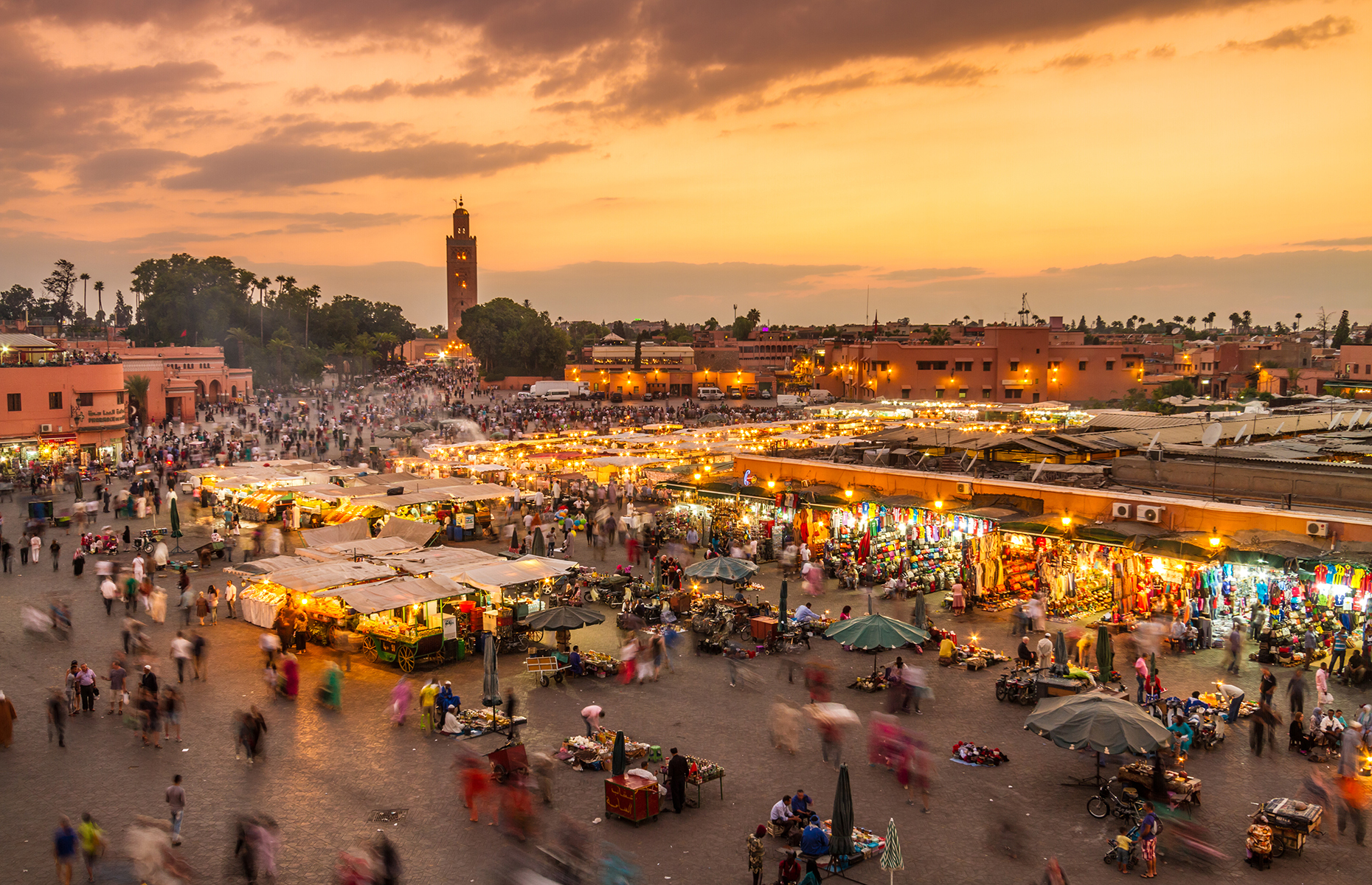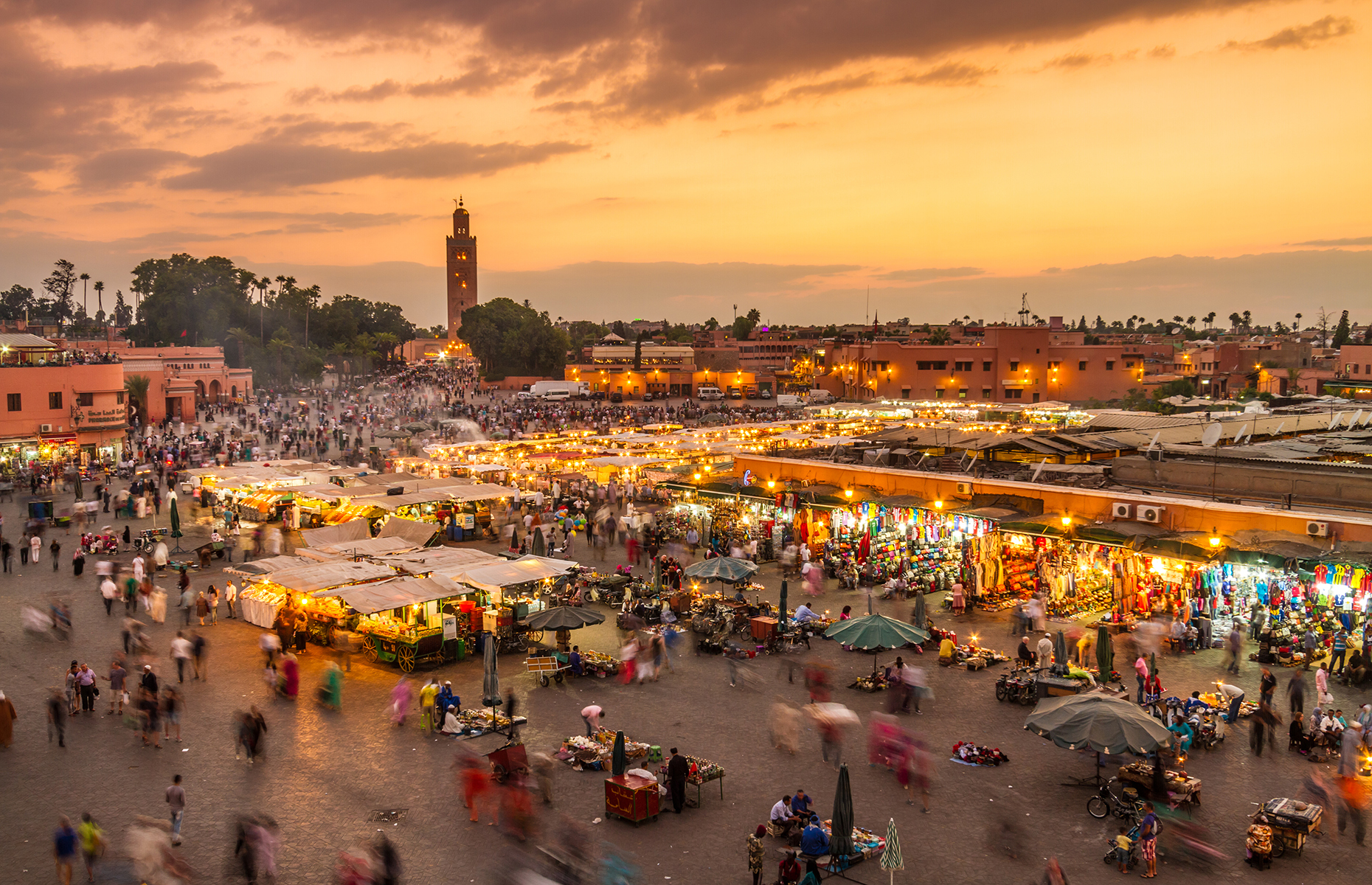
Marrakech, the Ochre City, is a destination that ignites the senses and whispers tales of ancient caravans and vibrant Berber culture. Nestled at the foot of the majestic Atlas Mountains, this Moroccan jewel offers a captivating blend of bustling souks, serene gardens, and a palpable sense of history that has drawn travelers for centuries. Whether you’re a seasoned adventurer or a curious neophyte, a journey to Marrakech promises an unforgettable tapestry of experiences. This comprehensive guide will equip you with everything you need to navigate this enchanting city, from its storied past to its modern-day allure.
A Glimpse into Marrakech’s Rich Tapestry: History and Heritage
The story of Marrakech is as vibrant and complex as its famed marketplaces. Founded in the 11th century by Yusuf ibn Tashfin of the Almoravid dynasty, Marrakech quickly rose to prominence as a crucial trading hub connecting sub-Saharan Africa with the Mediterranean. Its strategic location and fertile lands made it a prosperous center, and its rulers adorned it with magnificent palaces, mosques, and fortifications, many of which still stand today.

Related Articles about Marrakech: A Sensory Symphony of Spice, Souks, and Sahara Dreams:
- Slovenia: A Jewel of Europe – Unveiling its Top Attractions and Essential Travel Guide
- The Dragon Awaits: Your Comprehensive Guide to Traveling in China
- The Azure Dream: Your Ultimate Guide to Traveling to the Maldives
- Ascend to the Clouds: An Unforgettable Journey Through Machu Picchu
- Paradise Found: Unveiling Fiji’s Finest Hotels and Unforgettable Experiences
The Almoravids were succeeded by the Almohads, who further expanded and beautified the city, leaving their architectural mark with impressive structures like the Koutoubia Mosque. The Saadian dynasty later ruled, creating opulent mausoleums that are a testament to their wealth and artistry. During the French protectorate, Marrakech retained its cultural significance while embracing modern influences. Today, the city is a UNESCO World Heritage site, proudly preserving its historical treasures while pulsating with contemporary life.
Unveiling the Treasures: Top Attractions in Marrakech
Marrakech’s allure lies in its diverse array of attractions, catering to every interest and whim. Prepare to be captivated by these must-see sights:
-
Jemaa el-Fnaa: The Heartbeat of the City: This iconic square is the beating heart of Marrakech, a UNESCO-recognized masterpiece of intangible cultural heritage. By day, it’s a bustling marketplace with snake charmers, storytellers, and vendors selling fresh orange juice. As dusk descends, it transforms into a mesmerizing open-air restaurant, with dozens of food stalls serving up traditional Moroccan delicacies under a canopy of stars. The atmosphere is electric, filled with music, laughter, and the intoxicating aroma of spices.
-
The Koutoubia Mosque: A Spiritual Sentinel: Dominating the Marrakech skyline, the Koutoubia Mosque is an architectural marvel and a symbol of the city. While non-Muslims cannot enter, its magnificent minaret, a masterpiece of Almohad architecture, is a sight to behold, especially when illuminated at night. Its intricate detailing and soaring height are truly impressive.

-
The Bahia Palace: A Symphony of Moroccan Craftsmanship: Step into a world of opulent beauty at the Bahia Palace, a 19th-century marvel showcasing the zenith of Moroccan decorative arts. Wander through its tranquil courtyards, intricately tiled rooms, and serene gardens, adorned with mosaics, stucco work, and cedarwood carvings. It offers a glimpse into the lavish lifestyle of its former Grand Vizier.
-
The Saadian Tombs: A Hidden Gem of Serenity: Discovered only in the early 20th century, the Saadian Tombs are a beautifully preserved testament to the Saadian dynasty. These elaborately decorated mausoleums, particularly the Chamber of the Twelve Columns, are adorned with exquisite tilework, carved stucco, and precious marbles, offering a tranquil and poignant glimpse into Marrakech’s royal past.
-
The Majorelle Garden: A Splash of Cobalt Blue: Designed by French painter Jacques Majorelle and later owned by Yves Saint Laurent and Pierre Bergé, the Majorelle Garden is an oasis of vibrant colors and exotic flora. The striking cobalt blue of the buildings, known as "Majorelle Blue," stands in stunning contrast to the lush greenery of cacti, bamboo, and bougainvillea. It’s a perfect escape from the city’s hustle and bustle.
-
The Mellah (Jewish Quarter): A Cultural Mosaic: Explore the historic Mellah, once the heart of Marrakech’s Jewish community. Wander through its narrow streets, discover the Synagogue, and soak in the unique atmosphere that reflects a rich multicultural heritage.
-
The Tanneries: A Raw and Aromatic Experience: For the adventurous traveler, a visit to the tanneries offers a visceral insight into a traditional craft. Witness the age-old process of leather tanning, but be prepared for the pungent aroma. It’s an authentic and eye-opening experience.
-
The Souks: A Labyrinth of Treasures: No visit to Marrakech is complete without getting lost in its labyrinthine souks. These vibrant marketplaces are a sensory overload, brimming with everything from hand-woven carpets and intricate lanterns to fragrant spices and traditional leather goods. Haggling is an art form here, so embrace the experience and enjoy the playful negotiation.
Navigating the Ochre City: Travel Tips for a Seamless Journey
To make the most of your Marrakech adventure, keep these practical tips in mind:
- Visa Requirements: Check the visa regulations for your nationality before your trip. Many nationalities can enter Morocco visa-free for short stays.
- Currency: The Moroccan Dirham (MAD) is the official currency. It’s advisable to have some cash for smaller purchases and markets, though credit cards are increasingly accepted in larger establishments.
- Language: Arabic and Berber are the official languages. French is widely spoken, especially in tourist areas. English is also understood by many in the tourism sector.
- Dress Code: Morocco is a Muslim country, and while Marrakech is relatively liberal, it’s respectful to dress modestly, especially when visiting religious sites. Shoulders and knees should ideally be covered.
- Scams and Haggling: Be aware of common tourist scams, such as overcharging for taxis or being pressured into buying goods. Haggling is expected in the souks, but do so politely and with a smile. Have a price in mind before you start negotiating.
- Hydration: The Moroccan sun can be intense. Drink plenty of water, especially during warmer months. Bottled water is readily available.
- Food and Drink: Embrace the local cuisine! Tagines, couscous, pastilla, and mint tea are culinary delights. Be mindful of where you eat; stick to busy stalls and restaurants in Jemaa el-Fnaa for a safe and authentic experience.
- Photography: Always ask for permission before taking photos of people, especially in the souks.
- Getting Around: Taxis are plentiful, but agree on a price before starting your journey. Petit taxis are for within the city, while Grand taxis operate for longer distances. Walking is the best way to explore the Medina.
- Respectful Behavior: Be mindful of local customs and traditions. Avoid public displays of affection and be respectful of prayer times.
Finding Your Sanctuary: Accommodation Options in Marrakech
Marrakech offers a diverse range of accommodation to suit every budget and style, from opulent riads to modern hotels:
-
Riads: For an authentic Moroccan experience, a stay in a riad is highly recommended. These traditional Moroccan houses, often hidden behind unassuming doors in the Medina, feature inner courtyards with fountains, lush gardens, and beautifully decorated rooms. They offer a tranquil escape from the bustling streets and a taste of traditional hospitality. Many riads also offer delicious home-cooked meals.
-
Hotels: Marrakech boasts a wide array of hotels, from luxurious five-star resorts with swimming pools and spas to more affordable boutique hotels. These are often located in the Gueliz district (the modern part of town) or within the Medina, offering varying levels of comfort and amenities.
-
Guesthouses and Hostels: For budget-conscious travelers, guesthouses and hostels offer a more communal and affordable option. They are a great way to meet other travelers and often provide a friendly and welcoming atmosphere.
-
Villas and Apartments: For families or groups, renting a villa or apartment can be a convenient and cost-effective choice, offering more space and privacy.
Seamless Travel: Transportation to and Within Marrakech
Getting to and around Marrakech is relatively straightforward:
Getting To Marrakech:
- By Air: Marrakech Menara Airport (RAK) is the main gateway to the city and receives flights from numerous international destinations across Europe and beyond.
- By Train: Morocco has an extensive train network, and you can reach Marrakech from other major cities like Casablanca, Rabat, and Tangier.
- By Bus: Intercity bus services are also available, offering a more budget-friendly option for reaching Marrakech.
Getting Around Marrakech:
- Petit Taxis: These are the most common form of transport within the city. They are usually painted in a specific color (often cream). Always agree on the fare before you get in, as they don’t always use meters.
- Grand Taxis: These larger taxis are typically used for longer journeys outside the city or between different parts of the city. They operate on fixed routes and can be a more affordable option if you’re sharing with others.
- Walking: The Medina is best explored on foot. Allow yourself to wander through its narrow alleyways and discover hidden gems.
- Horse-drawn Carriages (Caleches): A romantic way to see the city, especially around the ramparts and Jemaa el-Fnaa. Again, agree on the price beforehand.
- Motorbikes and Scooters: While readily available for rent, navigating the busy streets of the Medina on a motorbike can be challenging and potentially dangerous.
The Perfect Time to Bloom: Best Time to Visit Marrakech
Marrakech experiences a desert climate with hot summers and mild winters. The best time to visit depends on your preferences for weather and crowds:
-
Spring (March to May): This is arguably the most pleasant time to visit. The weather is warm and sunny, with temperatures ranging from the low 20s to high 20s Celsius (70s Fahrenheit). The gardens are in full bloom, and the city is alive with energy.
-
Autumn (September to November): Similar to spring, autumn offers excellent weather with warm days and cooler evenings. The crowds are generally smaller than in spring, making it a great time for exploring the souks and attractions at a more leisurely pace.
-
Winter (December to February): Winters are mild and pleasant, with daytime temperatures typically in the mid-teens to low 20s Celsius (60s Fahrenheit). Evenings can be cool, so pack layers. This is a good time to visit if you prefer fewer crowds and are looking for a break from colder climates.
-
Summer (June to August): Summers in Marrakech are extremely hot, with temperatures often soaring above 35-40°C (95-104°F). While you can still visit, it’s best to plan your activities for the early mornings and late evenings and seek refuge from the midday sun in air-conditioned spaces or by the pool.
Beyond the City Walls: Day Trips and Excursions
Marrakech serves as an excellent base for exploring the surrounding Moroccan landscape:
- Atlas Mountains: Embark on a day trip to the High Atlas Mountains, visit traditional Berber villages, and enjoy breathtaking scenery. Popular destinations include Imlil and Ourika Valley.
- Essaouira: This charming coastal town offers a refreshing contrast to Marrakech, with its relaxed atmosphere, fortified medina, and fresh seafood.
- Ouzoud Falls: Witness the majestic Ouzoud Falls, the highest waterfalls in Morocco, and enjoy the surrounding natural beauty.
- Agafay Desert: Experience the tranquility of the Agafay Desert, a stone desert located a short drive from Marrakech, for a camel ride and a sunset dinner under the stars.
Marrakech is more than just a destination; it’s an experience that will linger long after you’ve departed. It’s a city that challenges, delights, and enchants, inviting you to immerse yourself in its vibrant culture, rich history, and the warmth of its people. So pack your bags, open your mind, and prepare to be swept away by the magic of Marrakech.





